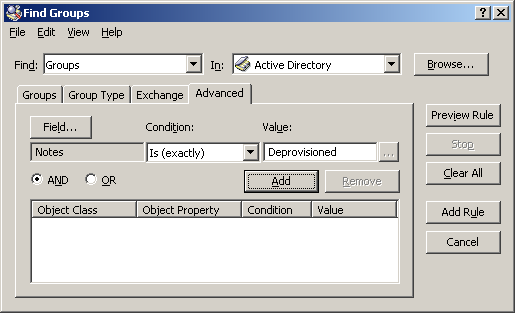This scenario describes how to configure a Managed Unit and a User Account Deprovisioning policy so that the Managed Unit includes all the deprovisioned user accounts. The policy sets the Notes property to Deprovisioned upon the user deprovisioning, whereas the Managed Unit is configured to include user accounts that have the Notes property set to Deprovisioned.
To implement this scenario, you must perform the following actions:
-
Create and configure the Managed Unit.
-
Configure the Policy Object that defines the appropriate policy.
-
Apply the Policy Object to a domain, OU, or Managed Unit.
As a result, after deprovisioning a user account in the container you selected in Step 3, Active Roles automatically adds that account to the Managed Unit you created in Step 1.
The following sections elaborate on the steps to implement this scenario.
You can create and configure the Managed Unit by using the Active Roles Console:
-
In the Console tree, under Configuration, right-click Managed Units, and select New > Managed Unit.
-
In Name, type a name for the Managed Unit. For example, you might type Deprovisioned Users.
-
Click Next.
-
Configure the membership rule to have the Managed Unit include the deprovisioned user accounts from all domains that are registered with Active Roles (managed domains):
-
On the wizard page, click Add.
-
In the Membership Rule Type dialog, click Include by Query, and then click OK.
-
Use the Create Membership Rule window to set up the rule:
-
In Find, click Users.
-
Click Browse and select Active Directory.
-
Click Advanced.
-
Click Field, and then click Notes.
-
In Condition, click Is (exactly).
-
In Value, type Deprovisioned.
At this stage, the window should look like the following figure.
Figure 88: Find Groups

-
Click Add.
-
Click Add Rule.
-
On the wizard page, click Add.
-
In the Membership Rule Type dialog, click Retain Deprovisioned, and then click OK.
-
Click Next, click Next, and then click Finish.
You can configure the Policy Object you need by modifying the Policy Object that implements the previous scenario, see Scenario 1: Disabling and renaming the user account upon deprovisioning.
Display the Properties dialog for that Policy Object and go to the Policies tab. Then, select the policy from the list, and click View/Edit to display the Group Object Deprovisioning Policy Properties dialog. Click Change Properties.
The Change Properties tab looks similar to the page of the same name in the wizard you used to create the Policy Object. You can use that tab to add the update rule for the Notes property:
-
Click Add to display the Select Object Property dialog.
-
Select the check box next to the Notes property, and then click OK.
-
In the Add Value dialog, type Deprovisioned in the ‘Notes’ must be box, and then click OK.
Click OK to close the Group Object Deprovisioning Policy Properties dialog.
You can apply the Policy Object without closing its Properties dialog. Go to the Scope tab and do the following:
-
On the Scope tab, click the Scope button to display the Active Roles Policy Scope window for the Policy Object you are managing.
-
Click Add and select the domain, OU, or Managed Unit where you want to apply the policy to.
You can also use the Remove button to remove items where you want the policy to no longer be applied.
-
Click OK to close the Active Roles Policy Scope window.
-
Click OK to close the Properties dialog for the Policy Object.
For more information on how to apply a Policy Object, see Applying Policy Objects and Managing policy scope.

